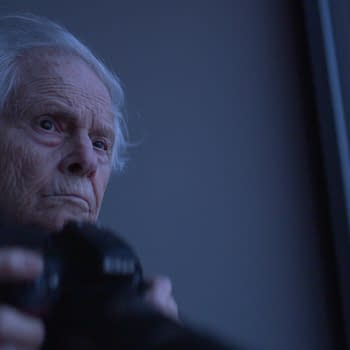Posted in: Movies, Recent Updates | Tagged: abigail breslin, i spit on your grave, steven monroe, wes bentley
Abigail Breslin, Steven Monroe And The Next Generation Of Rapesploitation
Two interlinked pieces of horror movie news landed on the internet just recently.
First up was artwork and casting news for Tyler Shields' slasher Final Girl: previously-named stars Abigail Breslin and Alexander Ludwig will now be joined by Wes Bentley, Michael Trevino, Connor Paolo and Francesca Eastwood, and the film is scheduled to begin shooting next month.
Final Girl is about a loner called Veronica, the new girl in school whose shy and vulnerable demeanour makes her the latest target for a group of boys who lure their female classmates out into the woods and proceed to torture and kill them. Little do they realise – SPOILER ALERT! – that the victim they've just chosen is a teenage assassin in training. Veronica escapes and turns the tables on her would-be killers, whom she has been assigned to kill as her final test.
The horror release schedule wouldn't be complete without a rape-revenge flick, and another film being announced in time for the American Film Market is Steven Monroe's I Spit On Your Grave Too, the follow-up to his 2010 remake I Spit On Your Grave, which was based on Meir Zachi's 1978 film of the same name. The sequel's script was written by Thomas Fenton, who was one of the writers for Saw IV.
Before taking a closer look at the two films, it's worth mentioning that it is not possible, nor would I ever attempt, to dismiss all rape-revenge films as 'rapesploitation' – sad attempts to justify casting a voyeuristic eye upon brutal sexual assault by "empowering" the female victim with a shotgun or butcher's knife in the final act of the film. There are some truly great horror films out there which employ rape-revenge plots without simply using them as an excuse to objectify women.
With that in mind, let's take a look at the first piece of artwork for Final Girl.
In case you're wondering, the girl in that picture is not Abigail Breslin, though she is probably intended to represent Breslin's character.
That's the artwork which is currently being presented to potential financiers for the film, and while the synopsis does not mention any act of rape committed towards the victims, the image is unmistakeably a pastiche of the box cover for both the 1978 and 2010 versions of I Spit On Your Grave, seen here side-by-side.
There is another strong connecting thread between Final Girl and I Spit On Your Grave Too. The trope of the "final girl" existed in horror films for many decades before it was properly examined in critical circles, embodied by victim-heroines like Laurie Strode, Ellen Ripley, Sally Hardesty, Nancy Thompson, Kirsty Cotton and … well, you get the idea. The term was coined by Carol J. Clover in her 1993 book Men, Women, and Chain Saws: Gender in Modern Horror Film, who had this to say about the appeal of the final girl trope.
The image of the distressed female most likely to linger in memory is the image of the one who did not die: the survivor, or Final Girl. She is the one… who is chased, cornered, wounded; whom we see scream, stagger, fall, rise, and scream again.
Men, Women And Chain Saws also frequently returns to I Spit On Your Grave as an ideal text through which to study gender representation in horror film, which was a genre primarily marketed towards a male audience. Clover does not try to assign an agenda to the film (which has, over many years of review, been described as everything from disturbing misogynist trash to a radically feminist text), but instead uses it to deconstruct revenge-plot films wherein the protagonist becomes both victim and monster. The interpretation is described very succinctly in an analysis of Brian de Palma's 1976 adaptation of Carrie.
Where exactly is the horror here? If "women's liberation" is the fear, is Carrie its representative monster, and if she is, who is the victim, and who is the hero?
The answer would seem to be that, like Samson, Carrie is all three in turn. Throughout most of the movie she is the victim of monstrous schoolmates and a monstrous mother, but when, at the end, she turns the tables, she herself becomes a kind of monstrous hero – hero insofar as she has risen and defeated the forces of monstrosity, monster insofar as she has herself become excessive, demonic.
One of the conclusions that Clover draws is that the final girl is "a congenial double for the adolescent male", carrying enough 'masculine' traits to be relatable for a male audience, but also feminine enough that her acts of sadism are more easily met with approval than if committed by a male; the underlying fantasy is that of excessive violence, not sexuality. Of course, that's not to say that a certain percentage of the demographic won't simply watch rape-revenge films because there is a decent likelihood of female full-frontal nudity, not to mention the potential indulgence for rape-fetishism, but generally speaking the appeal lies in the "revenge" aspect of the sub-genre.
I've been guilty before of judging films based solely on their trailers, but given that neither Final Girl nor I Spit On Your Grave Too have actually started shooting yet, I think it would be a little premature of me to either start denouncing them as torture porn, or accusing them of being insensitive towards the deeply personal and sensitive topic of rape and sexual assault. Just a little bit.
What I can, and happily will do, is criticise the fact that the gender politics of marketing films like this has not progressed since the 70s. It's not out of fond-hearted nostalgia that an almost identical image was used for the 2010 remake of I Spit On Your Grave as for the 1978 VHS cover; the original was a low-budget flick with no advertising budget which nonetheless saw significant popularity both in sales and rentals, and it's not a stretch to say that it was the image of a woman's body wearing nothing but a torn blouse and panties, seen from the rear end with the head conveniently decapitated by the top edge of the box, which got people slapping down their coin on the counter. Sex sells, regardless of consent.
The synopsis for I Spit On Your Grave Too, given here in paraphrasing and exact quotes by Shock Till You Drop, is this.
Production is expected to begin next month and, this time, the film centers on "naturally beautiful" Jessica who has just settled into New York where she, like many other young women, is trying to make it as a model. But what starts out as an innocent and simple photo shoot soon turns into something disturbingly unthinkable. Raped, tortured and kidnapped to a foreign country, Jessica is buried alive and left to die. Against all odds, she manages to escape. Severely injured, she will have to tap into the darkest places of the human psyche to not only survive, but to exact her revenge.
Again, I will refrain from commenting on the film's agenda because it hasn't been made yet, but it's worth noting that in the first film the rape victim was a writer who goes to the countryside on a retreat so that she can focus on her work. Now, in the sequel, she is a model whose career is entirely dependent on her looks, and it's dreadfully important to emphasise that she's "naturally beautiful": a girl-next-door type of beauty, as opposed to a silicone bimbo.
The synopsis also strongly suggests that the only connecting thread between I Spit On Your Grave and I Spit On Your Grave Too is that the protagonist gets raped and then takes revenge on her attackers. It's a thematic sequel rather than a narrative one, and the theme is gang rape. I guess it's good to stick to what you know?
I believe that it should be possible to make a film on just about any subject, whether it be assault, murder, or rape, provided the material is handled with talent, purpose, and sensitivity. Both Final Girl and I Spit On Your Grave Too are being taken the American Film Market next month, and their marketing pitches have been predominantly based upon the sexiness of their female victims. Welcome back to the seventies.
















